|
|
|
Sort Order |
|
|
|
Items / Page
|
|
|
|
|
|
|
| Srl | Item |
| 1 |
ID:
132864


|
|
|
|
|
| Publication |
2014.
|
| Summary/Abstract |
This article draws on fourth generation strategic culture debates to show the gap between the rhetoric of Australian defence and the more modest reality. Our analysis shows that these limits derive from tensions between national strategic culture and organizational strategic subcultures. There are serious debates in the nation regarding the preferred course of the Australian military and security policy. This article frames these debates by examining the 'keepers' of Australia's national strategic culture, the existence of several competing strategic subcultures, and the importance of norm entrepreneurs in changing defence and national security thinking. Strategic subcultures foster compartmentalization, constraints, and bureaucratic silos that narrow national conceptions of security threats and opportunities, and impinge on the formation of coherent foreign and defence policy in relation to the Asia-Pacific region. This analysis shows that a distinct national strategic culture and organizational strategic subcultures endure beyond individual governments, placing potential limits on Australia's interface with other Asia-Pacific strategic cultures in the future.
|
|
|
|
|
|
|
|
|
|
|
|
|
|
|
|
| 2 |
ID:
132868
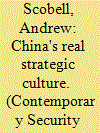

|
|
|
|
|
| Publication |
2014.
|
| Summary/Abstract |
The Great Wall is frequently held up as the most striking symbol of the potency of a persistent Chinese pacifist, non-expansionist, defence-minded strategic stance. But how accurate is this 'Great Wall' depiction of China's strategic culture? What is the impact of this depiction on China and the Asia-Pacific region? While the Great Wall is an apt symbol of a romanticized image of Chinese strategic culture, the reality behind the genesis of this impressive fortification and the accompanying pervasive belief in a monistic strategic tradition is that they are figments of the collective contemporary Chinese imagination. Nevertheless, these formidable myths exert real influence on two 'faces' of strategic culture. The first face refers to how leaders and society perceive the policies and actions of their own country. The second face, routinely neglected, refers to how leaders and society in one state perceive the policies and actions of an adversary or potential adversary state, which, like the first face, is constructed out of myth. The impact of these two faces on the Asia-Pacific region exacerbates the region's security dilemma, adversely impacting China's relations with other countries, notably Japan and the United States.
|
|
|
|
|
|
|
|
|
|
|
|
|
|
|
|
| 3 |
ID:
132869
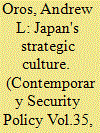

|
|
|
|
|
| Publication |
2014.
|
| Summary/Abstract |
Japan has shown three distinct strategic cultures since its emergence as a modern state in the 19th century: isolationist and non-military, militarist, and post-World War II strategic culture characterized by great reluctance to use military power abroad, even in collective self-defence. This article examines Japan's strategic culture and the potential for a fourth distinct strategic culture through the broader framework of security identity, arguing that this is evolving but has not changed as much as one might expect due to institutionalized antimilitarism and political support for the security practices it has engendered. Contemporary Japanese strategic culture can be understood through debates over recent Japanese security policy as well as actual changes in security practice. Domestic politics and a changing international environment are likely to lead Japan to a somewhat more active military role in the near term, but an analysis based on the dynamics of Japan's dominant security identity suggests that its strategic culture will continue to show a reluctance to use or develop military power beyond very limited scenarios, despite vocal efforts by some political actors to increase military activity abroad.
|
|
|
|
|
|
|
|
|
|
|
|
|
|
|
|
| 4 |
ID:
132870
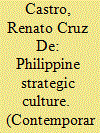

|
|
|
|
|
| Publication |
2014.
|
| Summary/Abstract |
Japan has shown three distinct strategic cultures since its emergence as a modern state in the 19th century: isolationist and non-military, militarist, and post-World War II strategic culture characterized by great reluctance to use military power abroad, even in collective self-defence. This article examines Japan's strategic culture and the potential for a fourth distinct strategic culture through the broader framework of security identity, arguing that this is evolving but has not changed as much as one might expect due to institutionalized antimilitarism and political support for the security practices it has engendered. Contemporary Japanese strategic culture can be understood through debates over recent Japanese security policy as well as actual changes in security practice. Domestic politics and a changing international environment are likely to lead Japan to a somewhat more active military role in the near term, but an analysis based on the dynamics of Japan's dominant security identity suggests that its strategic culture will continue to show a reluctance to use or develop military power beyond very limited scenarios, despite vocal efforts by some political actors to increase military activity abroad.
|
|
|
|
|
|
|
|
|
|
|
|
|
|
|
|
| 5 |
ID:
132872
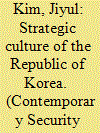

|
|
|
|
|
| Publication |
2014.
|
| Summary/Abstract |
The strategic culture of the Republic of Korea (ROK or South Korea) is based on three pillars: attaining prosperity and strength as an enduring national purpose and objective; countering the existential North Korean threat; and maintaining a strong alliance with the United States. This strategic culture is grounded in history, especially in Koreans' sense of themselves as an ancient and homogeneous people, the minjok, and in a constructed martial heritage. Keepers of strategic culture include the national security establishment, the National Assembly, the media, the public, and the United States, but the most important keeper is the president, who ultimately defines South Korea's strategic interests and how they should be attained or guarded. Contemporary illustrations of South Korean strategic culture in action include defence reform measures, shifts in the American alliance, and the 'crisis of 2013', which included a North Korean nuclear test and extreme threats of war. This article reinforces the view that while strategic culture may be a universal concept, in its operationalized and practised form, the true value of the concept is that the unique and particularistic characteristics that define each specific strategic cultural tradition are placed at the centre of analysis. South Korea's strategic culture is unique, but if there is an aspect that can be applied to other nations it is that shared historical memory and public historiography are crucial factors that inform that nation's strategic culture
|
|
|
|
|
|
|
|
|
|
|
|
|
|
|
|
| 6 |
ID:
132862
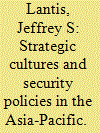

|
|
|
|
|
| Publication |
2014.
|
| Summary/Abstract |
Reflecting the culturalist turn in security studies, this special issue shows how one of the most powerful tools of security studies illuminates the origins and implications of the region's difficult issues, from the rise of China and the American pivot, to the shifting calculations of other regional actors. Strategic culture sometimes challenges and always enriches prevailing neorealist presumptions about the region. It provides a bridge between material and ideational explanations of state behaviour and helps to capture the tension between neoclassical realist and constructivist approaches. The case studies survey the role of strategic culture in the behaviours of Australia, China, Japan, the Philippines, South Korea, and the United States. They show the contrast between structural expectations and cultural predispositions as realist geopolitical security threats and opportunities interact with domestic elite and popular interpretation of historical narratives and distinctive political-military cultures to influence security policies. The concluding retrospective article devotes special attention to methodological issues at the heart of strategic cultural studies, as well as how culture may impact the potential for future conflict or cooperation in the region. The result is a body of work that helps deepen our understanding of strategic cultures in comparative perspective and enrich security studies. As disputes intensify over territory and resources, as regional militaries develop and leaders adjust their strategic calculus and defence commitments, the dovetailing of culture and politics in the Asia-Pacific shows through.
|
|
|
|
|
|
|
|
|
|
|
|
|
|
|
|
| 7 |
ID:
132874
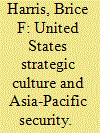

|
|
|
|
|
| Publication |
2014.
|
| Summary/Abstract |
This article adopts an historical socio-cultural lens to analyse the United States' strategic cultural tendencies. It traces the roots of the mutually constitutive relationship between technology and political structures in the United States to explain the dominant tendency of the United States to substitute technology for strategy in war as a predisposition of national strategic culture. This predisposition was seen particularly in network-centric warfare and effects-based operations. I conclude that the United States risks strategic failure due to the limitations of its ethnocentric security paradigm. Over-reliance on technology obscures strategic understanding of the people and cultures of the world, including those of the Asia-Pacific region. The development of the AirSea Battle is a case in point, a direct application of technology to strategic concerns in the Asia-Pacific region. The strategic pivot towards the Asia-Pacific may be characterized as reflecting more historical continuity than change in America's strategic calculus. The emerging Asia-Pacific security dynamic is no different a challenge for American policy-makers in that regard than challenges presented elsewhere in the world. Perhaps the biggest challenge for American leaders is to overcome institutional intransigence or the lure of ideological conformity when addressing military requirements and budgetary commitments.
|
|
|
|
|
|
|
|
|
|
|
|
|
|
|
|
| 8 |
ID:
132875
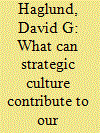

|
|
|
|
|
| Publication |
2014.
|
| Summary/Abstract |
This article reflects on application of the concept of strategic culture to supply analytical and policy-relevant guidance to those who ponder the future of security relations in the Asia-Pacific. Argued here is that, notwithstanding some obvious problems with the concept, there is utility in the application of strategic culture to the analysis of regional security challenges. To claim that strategic culture may not be equally applicable to all states in the Asia-Pacific region is not the same as saying it has no applicability at all, especially if the states to which it is applicable are important regional actors. This article suggests that both an old approach derivative of national character, and a new one associated with path dependence, might together prove fruitful for policy analysts and policy-makers alike, as they wrestle with what many assume to be the fundamental question of the coming half-century in the Asia-Pacific, namely whether a great power war in the region can be averted. Although there is much variation in the manner with which authors apply the master concept of strategic culture to their specific Asia-Pacific cases, each takes seriously the utility of a cultural approach to national strategic choice. So while the quest for reliable causality and predictive capability on a region-wide basis may remain that of the will-o'-the-wisp, there can be no gainsaying that, on a case-by-case basis, the authors show that the approach can demonstrate valuable insights into the policy dilemmas of cultural provenance and content confronting the Asia-Pacific.
|
|
|
|
|
|
|
|
|
|
|
|
|
|
|
|
|
|
|
|
|